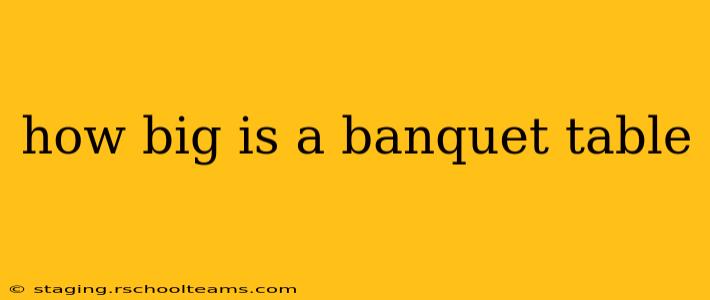Banquet tables are essential for large gatherings, from weddings and corporate events to conferences and family reunions. But understanding their dimensions is crucial for proper planning and efficient space utilization. This guide will delve into the standard sizes, variations, and considerations for choosing the right banquet tables for your event.
What are the standard dimensions of a banquet table?
The most common banquet table size is 6 feet (72 inches) long by 30 inches wide. This rectangular shape is versatile and accommodates a comfortable number of guests. However, it's important to note that these dimensions can vary slightly depending on the manufacturer. Some tables might be slightly longer or shorter, and the width can also fluctuate marginally.
What are the different types of banquet tables?
Beyond the standard 6-foot rectangular table, several other types cater to different needs and space constraints:
-
8-foot Rectangular Tables: Offering increased seating capacity, these tables are ideal for larger gatherings or when you need to accommodate more people per table.
-
Round Banquet Tables: These tables are often preferred for more intimate settings and facilitate better conversation flow among guests. Diameters vary, with common sizes being 60 inches and 72 inches.
-
Square Banquet Tables: While less common than rectangular tables, square banquet tables provide a structured and efficient layout, particularly beneficial for smaller events or when precise space allocation is critical.
-
Half-Round Banquet Tables: These tables are designed to be placed against a wall or used to create unique table arrangements. They combine the intimacy of a round table with the space-saving benefits of a half-circle design.
How many people can sit at a banquet table?
The seating capacity of a banquet table depends on several factors:
-
Table Size: Naturally, larger tables accommodate more guests. A standard 6-foot rectangular table typically seats six to eight people comfortably, while an 8-foot table can seat eight to ten.
-
Chair Size: The size and type of chairs used will impact seating capacity. Larger chairs will reduce the number of people that can comfortably fit around the table.
-
Placement of Serving Dishes: Leaving enough space for serving dishes and centerpieces on the table will influence the number of seated guests.
-
Guest Comfort: Allowing ample personal space for each guest is crucial for a comfortable dining experience. Cramped seating can negatively impact the overall event atmosphere. A general rule of thumb is to allow approximately 24 inches per person.
How much space do I need between banquet tables?
Adequate spacing between tables ensures easy access for guests and servers. A minimum of 36 inches (3 feet) between tables is recommended to allow for comfortable movement and prevent congestion. In larger venues or for events with a high number of attendees, increasing this space to 48 inches or even more may be advisable.
What are some alternative sizes for banquet tables?
While the standard sizes are widely available, some manufacturers offer variations. You might encounter slightly larger or smaller tables, particularly from specialist rental companies catering to specific event types. It's always best to confirm the exact dimensions when renting or purchasing.
What materials are banquet tables typically made of?
Banquet tables are commonly made from various materials, each with its advantages and disadvantages:
- Plastic: Lightweight and affordable, plastic tables are portable but may be less durable than other options.
- Wood: Offers a classic and elegant look, but wooden tables are heavier and more expensive.
- Metal: Durable and sturdy, metal tables are often favored for their resilience, although they might be less visually appealing than wood.
This comprehensive guide should help you navigate the world of banquet table sizes and configurations. Remember to always prioritize guest comfort and efficient space planning to create a successful and enjoyable event. Remember to check with your venue or rental provider for specific dimensions and available options.
